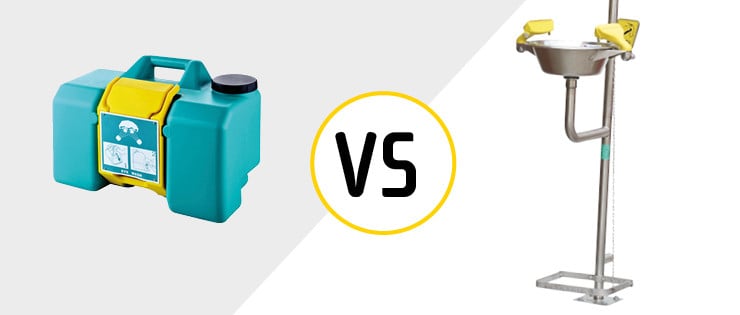If there is potential for a person in your workplace to receive an eye injury, it is essential that it is fitted out with an eye wash station that meets AS 4775-2007, emergency eyewash and shower equipment. This eye wash station must be situated within 10 seconds from the hazardous area, level with its surrounds, well signposted, and free of obstruction.
The eye wash station itself must provide at least 15 minutes of freely flowing tepid water at a minimum rate of 1.5L/min. The spray pattern should adequately cover both eyes. Once activated, this should all occur without the use of hands. There are no mandatory water temperature requirements, but it is recommended that water stay between 15.6 – 37.8 degrees Celsius.
As per the requirements of AS 1318-1994, safety signs for the occupational environment, all emergency information signs, including the location of emergency eye wash stations must be green with a white pictogram or symbol. To ensure proper function, eye wash stations must be checked regularly.

Read more on Eye Protection Signage.
Plumbed vs. Portable Eyewash Stations
If your worksite and job application will remain fairly unchanged over the years to come, a plumbed option will work for you. Although more expensive than a portable machine to install, they are reliable and easy to maintain. Once installed, a plumbed station needs to be activated once a week to ensure that there is no sediment, bacteria or mould built up in the pipes.
Portable stations are ideal if your worksite and tasks are dynamic. They provide the flexibility of being able to transport your station without the expense of installation fees.

Tap Water vs. Sterile Solution
Tap water stations are available in both plumbed and portable models. Although convenient, some experts have noted that tap water has the potential to cause even greater damage to the affected eye in the event of infection. This is because tap water, although controlled may not offer a bacteria-free water supply.
Sterile solutions and cartridges are treated and packed in clean rooms to ensure that absolutely no bacteria contaminate the water. Because of this, sterile solutions have a shelf life. This is commonly for 24 months. After this, the sterile solution needs to be replaced.
Supplementary Eye Wash Solutions
Alongside the primary eye wash station, it is recommended in areas of high risk that supplementary eye wash stations are also available. This includes smaller, portable eyewash stations or personal eye wash solutions.
 |
What is DIPHOTERINE® Solution?DIPHOTERINE® is an emergency decontaminate for eye and skin chemical splashes. The sterile solution neutralises any chemicals that find their way onto the skin or into the eyes. If applied immediately after the chemical splash DIPHOTERINE® can minimise or prevent the appearance of legions and the risk of subsequent infections. DIPHOTERINE® is recommended for nearly all chemical substances, such as acids, bases, oxidisers and solvents. Check with your ATOM Safety representative to find out if DIPHOTERINE® is a good choice for your workplace. |
Avoid emergency situations, and ensure that you and your team are wearing the proper eye protection for the task at hand.
